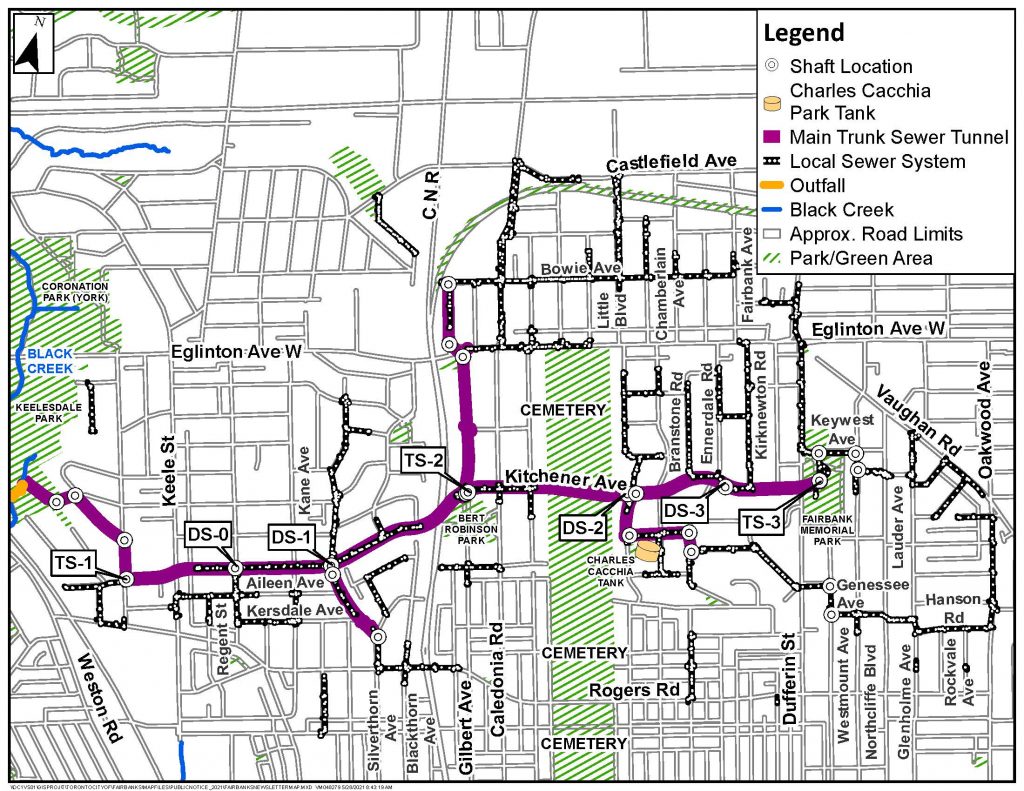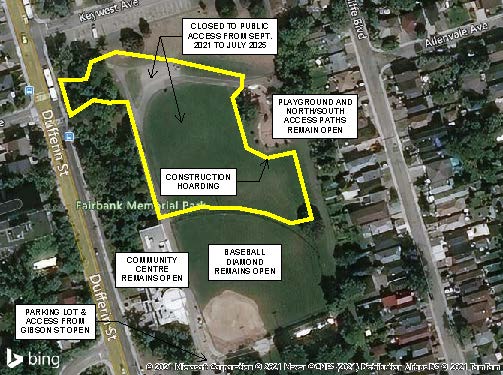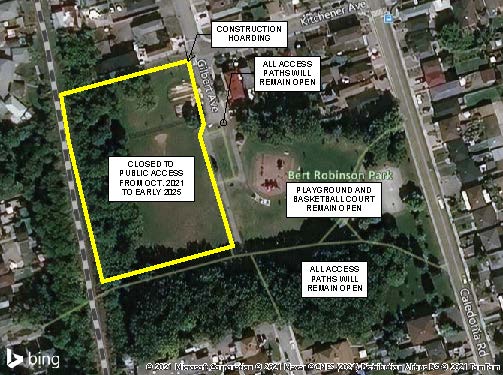
The City of Toronto, with support from the Government of Canada, is protecting against basement flooding in the Fairbank-Silverthorn community. The project involves three important infrastructure improvements:

When construction is complete, the new infrastructure will help to reduce sewer backups and basement flooding for more than 4,645 homes and provide flood protection to a 140-hectare area.
The project is part of the Council-approved 2021 Basement Flooding Protection Program and is funded in part by the Government of Canada through the Disaster Mitigation and Adaptation Fund. The Government of Canada has committed $73.2 million in funding for this project through the Disaster Mitigation and Adaptation Fund, a Canada-wide program to support large-scale infrastructure projects and help communities better manage the risks of disasters triggered by natural hazards. The City of Toronto is providing the remaining estimated funding of $250 million.
The City of Toronto hosted an information session in October 2024 to provide current updates on the status of Phase 1 construction, as well as details on the upcoming Phase 2 works. Please see below for the project overview, and upcoming works divided by ward:
Construction notices will be distributed to affected neighbourhoods in advance of any work taking place, in addition to being posted online below. Updates will be issued periodically as needed to keep the community informed of any changes to ongoing work. Please find the overall project construction notice below, as well as individual street construction notices organized by ward and street.
Kane Avenue (Traffic Conversion)
Landour Avenue
Woodborough Avenue and Castlefield Avenue
Woodborough Park
Caledonia Road and Bowie Avenue
Earlscourt Avenue
Earlsdale Avenue
Gilbert Avenue and Summit Avenue
Harvie Avenue, Redhill Avenue and Eglinton Avenue West
Oakwood Avenue (from Rogers Road to Holland Park Avenue)
Rowntree Avenue and Chambers Avenue
Blandford Street and Glenholme Avenue
Northcliffe Boulevard, Allenvale Avenue and Lauder Avenue
Oakwood Avenue (from Rogers Road to Holland Park Avenue)
Westmount Avenue (at Martin Street and at Genessee Avenue)
Throughout the project there will be periodic construction update notices mailed directly to the community in addition to project website updates and direct communication with local groups such as Business Improvement Areas, community groups, resident associations, and area schools.
Site specific construction notices organized by street name:
The City of Toronto, its contracted consultant Jacobs Engineering, and its subcontractor EBC-Bessac Canada JV began construction of the new storm trunk sewer and a portion of the new local storm sewers began and is anticipated to take four years to complete.

The new storm trunk sewer is currently under construction using a tunnel boring machine (TBM) which uses rotating disc-shaped cutting wheels that bore through soil and install pipe segments to create the tunnel walls at a depth of up to 40 metres below ground. Due to the high density and quantity of soil, sediments and materials below ground, the TBM is able to excavate approximately eight to ten metres per day. Currently, the tunnel boring machine has completed 40 percent of its planned tunnel route.
To lower and retrieve both the main tunnel boring machine, and other micro-tunnel boring machines that facilitate tunnel and sewer construction, twenty shafts were planned across the area. The majority of tunneling activity will be carried out through a large shaft in Fairbank Memorial Park. As of 2024, the twenty planned shafts have been completed, as well as all necessary micro-tunneling activity.
Construction activity in Fairbank Memorial Park began as planned in 2021, and is expected to finish in 2025. A large space within the park is required to construct a shaft where the contractor will carry out tunneling work with the tunnel boring machine. This work involves excavating the ground and importing precast concrete to construct the storm trunk sewer. Noise control measures, including a solid barrier, will be placed around the work area to control noise levels.
A portion of Fairbank Memorial Park will be closed to the public and temporary access for construction vehicles will be created at Dufferin Street and Rowan Avenue. Public access to the community centre and parking lot south of the centre will be maintained throughout construction, and the play area and the baseball field will remain open.
Construction will continue throughout 2024, and the TBM is expected to reach the end of its route in Winter 2024. Once the TBM is retrieved at the Bicknell Avenue and Nashville Avenue shaft, the shaft locations will be fully restored by the end of Summer 2025.
See the Project Maps for details.
The new local storm sewers will be constructed by micro-tunneling method along Silverthorn Avenue, Gilbert Avenue, Croham Road, Harvie Avenue and Chudleigh Road. Shallower and smaller shafts will be constructed for micro-tunneling at various locations.
These shaft sites will be restored by the end of August 2024.
See the Project Maps for details.
In the second phase of construction the City will construct approximately 17 km of new storm sewers and install additional inlet control devices (ICDs). 330 ICDs will be installed to restrict storm water from entering combined sewers, reducing combined sewer overflow and the risk of basement flooding.
When construction is completed, the contractor will restore local roads and tunnel shaft locations, including parks.
The following work was completed prior to construction starting.
Eglinton Cross Town LRT and Fairbank Storm Sewer system are serving different functions. The storm sewer is transferring water from individual streets to an outfall at Black Creek, while the transit system remains along the Eglinton corridor. It would be very challenging to drain the area to Eglinton Avenue, and the sewers would be deeper and more expensive. It would also increase the length of the disruption along Eglinton Avenue, as the timing of work on these projects is different timing and work is being carried out at different depths underground.
You may experience dust, noise and other inconveniences during construction. We appreciate your patience during this construction and will make efforts to reduce the impacts.
The route for the storm trunk sewer was selected to reduce impacts as much as possible, however, there are areas where construction activities will be carried out in close proximity to businesses and residential properties.
The City of Toronto will survey all properties within 100 metres of construction areas before work starts. The inspection will look at the interior and exterior of all properties to verify existing conditions. Although participation is voluntary, the City encourages all property owners to participate. Without the survey, it will be difficult to confirm any future claims of damage caused by construction.
Affected properties will receive a separate notice from OZA Inspections Ltd. to set up an appointment for the inspection. All inspection staff will wear photo identification and carry photo equipment for this work.
Monitoring for settlement and vibration will be carried out during construction. As part of the engineering design, assessments have been performed to evaluate the potential for settlement and vibration resulting from tunneling work and ensure that there is minimal potential impact.
Remove items located within City property limits (boulevard) to avoid damage. This includes items such as landscaping (plants and pavers), decorative objects, sprinkler systems or heated driveways. For more information, please contact the Field Ambassador.
Any temporary access disruptions will be communicated as soon as possible. If you experience a disruption, have a specific access need or related accommodation request please contact the Field Ambassador.
Please follow your normal routine. If required, the contractor will move bins to an appropriate location and return them. Please ensure that your bins are labelled with your address.
This work may affect phone and internet cables for individual properties that aren’t buried deep below the sidewalk. The contractor will coordinate with utility companies to minimize disruption. If your service has been disrupted, please contact the Field Ambassador and notify your phone or internet service provider.
The City has appointed a specialist designer and a specialist contractor, following a rigorous qualification process where the contractors demonstrated they have completed this type of work in the past. Throughout the project there will be a team monitoring all construction activity, and this team will have the capacity to respond to any unexpected events, should they occur.
If you have construction questions or an issue on site, ask to be directed to the Site Inspector. If the Site Inspector is unavailable, please contact the Field Ambassador.
Due to the nature of this project, the City will have to remove 27 street trees from the City’s boulevard throughout the project area, 39 trees from Fairbank Memorial Park, 19 trees from Bert Robinson Park, and 162 trees from
Keelesdale Park.
If the planned work affects a tree near your property, you will receive a notice in advance.
For removed street trees and trees removed from a park, there is a 3:1 ratio of replanting. The City will replant trees in the boulevard and within parks where there is adequate space.
The construction work area will be restored with sod, concrete and/or asphalt where required to its initial condition. Interlocking bricks, flagstone on a granular base, or other similar features that are removed from public and private
property during construction will be replaced.
Lawn seeding and/or laying of sod will be done as needed during ideal growing seasons only – in the spring (April to June) and fall (September to October).

Larger Fairbank Storm Sewer System Map


To relieve pressure on the existing combined sewer system, more than 17 km of new local sewers will be added to improve drainage on local streets and help reduce basement flooding. These local storm sewers will connect to the new storm trunk sewer.
During heavy rainstorms, excessive stormwater will be carried from the new local storm sewers to the new large storm trunk sewer. It will be a new tunnel 4.5 meters in diameter and 2.4 km long, and will range in depth from 15 to 40 meters below ground.
The new storm sewer tunnel will pass below Fairbank Memorial Park, Kitchener Avenue, Bert Robinson Park, Dunvaven Drive, Nashville Avenue, Bicknell Avenue and Westbury Crescent and end at Black Creek near Keelesdale Park.
The new storm trunk sewer will have the capacity to convey up to 9,500 litres of stormwater per second to Black Creek.
It is also designed to serve as temporary storage during heavy rainfall and will slow down the release of storm water to Black Creek.
As part of its construction, a new stormwater outfall will be constructed at Keelesdale Park to replace the existing outfall.
An underground storage tank located in Charles Caccia Park is currently in service and stores combined sewer flows during large storms from the area around the park. This 6,000 cubic meter storage tank helps to relieve the combined sewer system during rainfall. Using pumps, the tank is drained when the downstream sewer system is able to safely accept the flows (after a large rainstorm is over) and carry the flow to the wastewater plant for treatment.
The tank provides storm protection to the immediate neighborhood surrounding the tank, however, the construction of the new Fairbank Silverthorn storm trunk sewer will provide enhanced protection to the entire area.
The existing tank at Keelesdale park is for the combined sewer system, a mixture of surface runoff (rainwater) and foul water (sewage). The new storm trunk sewer system will collect and convey only surface storm water, diverting if from the combined system and reducing discharge from the combined system into Black Creek.
To construct the shaft at the south end of Keelesdale Park, heavy equipment will be required. Construction access to the park will be via Hyde Avenue. Area residents will receive update notices prior to the start of work in the park.
Inlet control devices (ICD) restrict rain water from entering the combined sewer system through catch basins, reducing combined sewer overflow and the risk of basement flooding. As a result, inlet control devices may increase temporary surface ponding on streets.
Between May and September 2020, 55 inlet control devices were installed to review their performance before proceeding with installation for the larger area.
Starting in 2022, an additional 330 ICDs will be installed to restrict storm water from entering combined sewers.
The new storm trunk sewer will be constructed 40-50 metres below the surface of the road, and all of the new local storm sewer infrastructure is buried. When the project is complete there will be a few more maintenance holes on the surface but no other infrastructure will be visible. The primary noticeable difference will be during large storm events, when more water will be successfully captured and conveyed to Black Creek, protecting homes, streets and parks from flooding.
The City of Toronto, with support from the Government of Canada, is protecting against basement flooding in the Fairbank-Silverthorn community for more than 4,656 homes. Subscribe to receive regular project updates.
Type (don’t copy and paste) your email into the box below, check the box next to the e-update description and then click “Subscribe”. You will receive an email with instructions to confirm your request.
While we aim to provide fully accessible content, there is no text alternative available for some of the content on this page. If you require alternative formats or need assistance understanding our maps, drawings, or any other content, please contact the Field Ambassador at fairbanksewer@toronto.ca or call 416-338-5497.